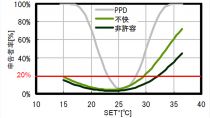Research on the Thermal Environment of Comfortable Train Station Spaces
2012-1001-07

- researcher's name
-
about researcher TANABE, Shinichi Professor
- affiliation
-
Faculty of Science and Engineering School of Creative Science and Engineering
- research field
-
Architectural environment/Equipment
- keyword
-
background
Train station spaces used to be considered places of transit. In the last few years, however, shops and cafes have sprung up at the central train stations in the Tokyo metropolitan area, and new ways of using train stations as “places to stay” are emerging. These developments have placed greater importance on the environment and comfort level of train stations. However, we believe semi-outdoor train stations need not all necessarily rely on air conditioning systems, irrespective of the size of the train station. By employing passive methods at relatively small train stations, we believe train stations may be designed without increasing the environmental footprint. At large terminal train stations installed with air conditioning systems, it is becoming important that the eco-friendliness and comfort level of train stations are enhanced, without letting outdoor air affect semi-outdoor train stations.
summary
A measurement survey conducted in 2004-2006 took environmental measurements at four non-air-conditioned train stations in Tokyo and implemented a questionnaire survey to roughly 4,000 people. The results showed that the maximum acceptable temperature declared by more than 20% of the respondents in the summer was the standard effective temperature (SET*) of 32˚C, and that the temperature exceeded this threshold limit in many time ranges. This threshold limit is higher than the maximum acceptable indoor temperature. The main factors attributed to hot train stations are weak air current and the considerable effects of the sun’s rays, and proposals are being studied to address these factors. In the FY2011 study, a measurement survey was conducted at train stations at which a large commercial facility and an air conditioning system were installed inside the ticket gate. The results demonstrated that although the maximum acceptable temperature and comfort level in the summer were the same as non-air conditioned train stations, the lower limit of the comfort range was higher for train stations installed with air conditioning systems. The inflow of outdoor air could inhibit thermal environment control inside a train station. Therefore, detailed analyses are being carried out of the factors, and countermeasure proposals are being reviewed.
application/development
Train stations have a variety of uses and exist in an array of forms. Examples include large terminal stations and stations that are the face of the community. By incorporating environmental engineering assessments, we believe design tools can be created to enhance the value of train stations that exist in a variety of shapes.
predominance
Train stations have high transport efficiency, i.e., CO2 emissions per number of people in the unit are lower than other means of transportation. By extension, it is deemed that raising the value of train station spaces, and thereby, increasing the number of train station users will ultimately allow for CO2 emissions reductions. Furthermore, train stations originally functioned as centers of communities, and towns developed around train stations. Against this background, it is believed that the vitalization of train stations may lead to the vitalization of communities.
material
same researcher's seeds
-
 Realizing Thermal Comfort by Spot Air Conditioning and Personal Air Conditioning Systems
Realizing Thermal Comfort by Spot Air Conditioning and Personal Air Conditioning Systems -
 Creation of Energy Projections and Environmental Measures Scenario
Creation of Energy Projections and Environmental Measures Scenario -
 Scenario of Achieving Both Office Productivity and Economic Efficiency, and Energy Conservation
Scenario of Achieving Both Office Productivity and Economic Efficiency, and Energy Conservation -
 Assessment of Comfort and Intellectual Productivity in ZEB Energy-Saving Buildings
Assessment of Comfort and Intellectual Productivity in ZEB Energy-Saving Buildings -
 Research on Semi-Volatile Organic Compounds (SVOCs) in Indoor Spaces
Research on Semi-Volatile Organic Compounds (SVOCs) in Indoor Spaces
posted:
2014/05/21



